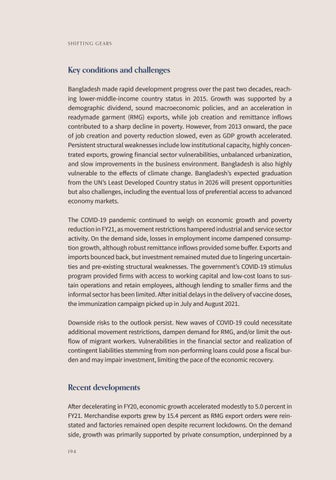shifting gears
Key conditions and challenges Bangladesh made rapid development progress over the past two decades, reaching lower-middle-income country status in 2015. Growth was supported by a demographic dividend, sound macroeconomic policies, and an acceleration in readymade garment (RMG) exports, while job creation and remittance inflows contributed to a sharp decline in poverty. However, from 2013 onward, the pace of job creation and poverty reduction slowed, even as GDP growth accelerated. Persistent structural weaknesses include low institutional capacity, highly concentrated exports, growing financial sector vulnerabilities, unbalanced urbanization, and slow improvements in the business environment. Bangladesh is also highly vulnerable to the effects of climate change. Bangladesh’s expected graduation from the UN’s Least Developed Country status in 2026 will present opportunities but also challenges, including the eventual loss of preferential access to advanced economy markets. The COVID-19 pandemic continued to weigh on economic growth and poverty reduction in FY21, as movement restrictions hampered industrial and service sector activity. On the demand side, losses in employment income dampened consumption growth, although robust remittance inflows provided some buffer. Exports and imports bounced back, but investment remained muted due to lingering uncertainties and pre-existing structural weaknesses. The government’s COVID-19 stimulus program provided firms with access to working capital and low-cost loans to sustain operations and retain employees, although lending to smaller firms and the informal sector has been limited. After initial delays in the delivery of vaccine doses, the immunization campaign picked up in July and August 2021. Downside risks to the outlook persist. New waves of COVID-19 could necessitate additional movement restrictions, dampen demand for RMG, and/or limit the outflow of migrant workers. Vulnerabilities in the financial sector and realization of contingent liabilities stemming from non-performing loans could pose a fiscal burden and may impair investment, limiting the pace of the economic recovery.
Recent developments After decelerating in FY20, economic growth accelerated modestly to 5.0 percent in FY21. Merchandise exports grew by 15.4 percent as RMG export orders were reinstated and factories remained open despite recurrent lockdowns. On the demand side, growth was primarily supported by private consumption, underpinned by a 194




